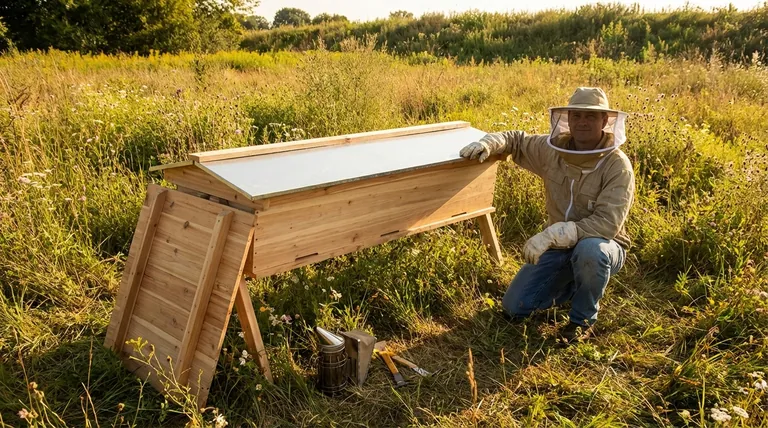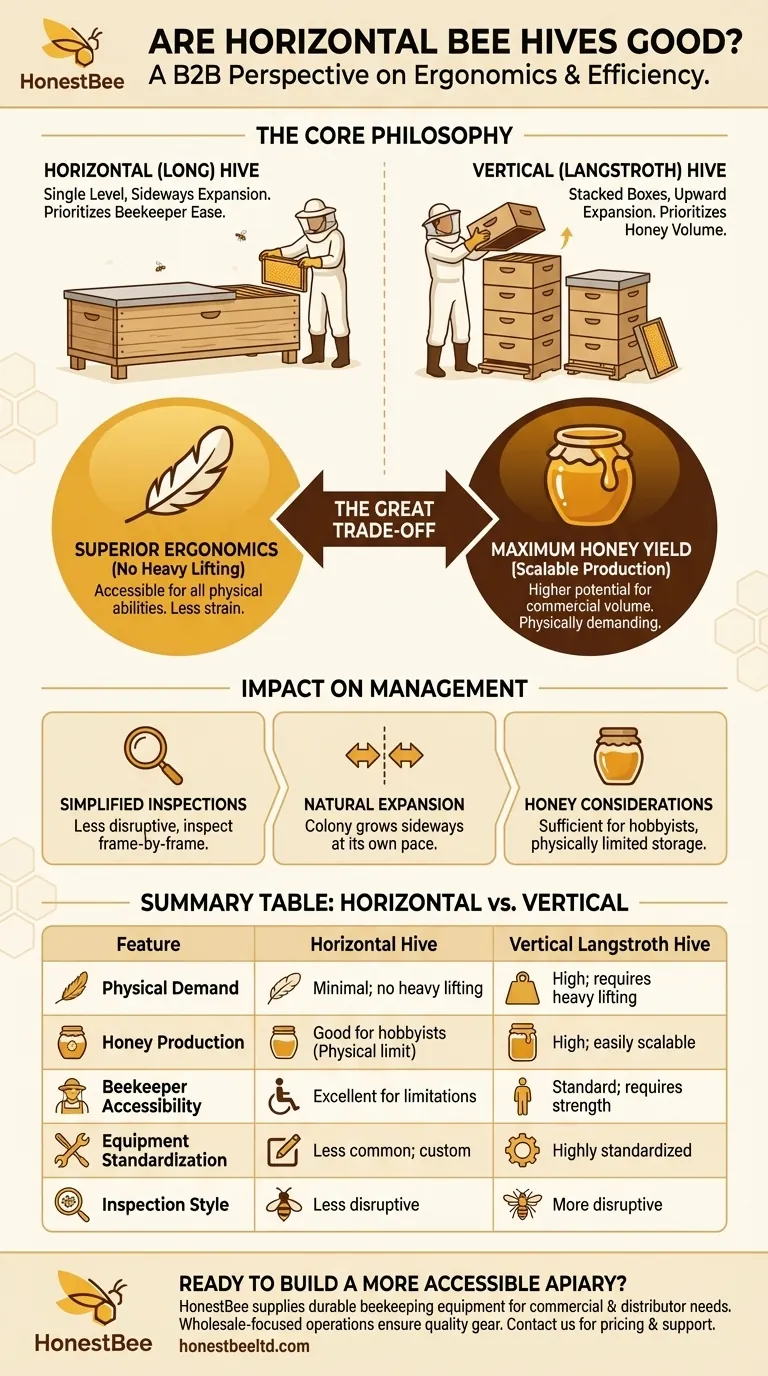For the right beekeeper, yes. Horizontal hives are a perfectly viable and often excellent choice, but they represent a specific compromise. They are primarily designed for the convenience and physical ease of the beekeeper, not for maximizing the honey production efficiency you might find in a standard vertical hive.
The core trade-off is simple: horizontal hives exchange the potential for maximum honey yield for superior ergonomics. They are an outstanding solution for beekeepers who want to eliminate heavy lifting from their hive management routine.

The Core Design Philosophy: Prioritizing the Beekeeper
Horizontal hives, often called "long hives" or "top-bar hives," operate on a fundamentally different principle than the familiar stacked boxes of a vertical Langstroth hive. Understanding this philosophy is key to deciding if one is right for you.
What is a Horizontal Hive?
Instead of stacking boxes (called "supers") vertically as the colony grows, a horizontal hive is a single, long box. The bees expand their brood nest and honey stores sideways along a single level.
The Ergonomic Advantage
This single-level design is the hive's greatest strength. All inspections and manipulations happen frame by frame without ever having to lift a heavy box full of honey, which can easily weigh over 50 pounds (23 kg).
A Compromise in Efficiency
A horizontal hive is a tool made for the beekeeper. While bees can thrive in them, the design doesn't necessarily cater to their natural inclination to store honey upwards, away from the brood. This is why they are often considered less efficient for sheer honey production compared to a towering vertical hive.
How Horizontal Hives Impact Bee Management
The physical design of a horizontal hive directly influences how you interact with the colony and how the bees organize themselves.
Simplified, Less Disruptive Inspections
You only need to open the part of the hive you want to inspect. This means less disturbance for the colony as a whole, as most of the hive remains covered and calm while you work on a few frames.
Natural Brood Nest Expansion
The colony can expand its brood nest sideways at its own pace. Many beekeepers feel this is a more natural progression, mimicking how bees might expand in a hollow log.
Honey Production Considerations
While a horizontal hive might not be the top choice for commercial-scale honey production, it can absolutely produce a surplus of honey. For the hobbyist or backyard beekeeper, the amount is often more than sufficient.
Understanding the Trade-offs
Choosing a hive style is about matching the equipment to your personal goals and physical capabilities. There is no single "best" hive.
Pro: Accessibility and No Heavy Lifting
This is the primary benefit. It makes beekeeping accessible to people with back problems, limited strength, or anyone who simply wants an easier physical experience.
Con: Potentially Lower Honey Yields
A strong vertical hive can be expanded almost infinitely upwards to capture a massive honey flow. A horizontal hive has a fixed length, which creates a physical limit on its maximum potential storage space.
Con: Custom Equipment
While many horizontal hives now use standard Langstroth frames, the hive bodies themselves are not standardized. This can make finding or building compatible equipment more challenging than with the ubiquitous Langstroth design.
Making the Right Choice for Your Goal
To determine if a horizontal hive is a "good" choice, you must first define your beekeeping objectives.
- If your primary focus is accessibility and avoiding heavy lifting: The horizontal hive is an exceptional choice that makes beekeeping physically sustainable.
- If your primary focus is maximizing honey production for sale: The vertical Langstroth hive is generally the more efficient and scalable option.
- If your primary focus is a simple, less intrusive backyard beekeeping experience: A horizontal hive aligns perfectly with this goal, offering easy inspections and happy bees.
Ultimately, the best hive is the one that keeps you engaged and effective as a beekeeper.
Summary Table:
| Feature | Horizontal Hive | Vertical Langstroth Hive |
|---|---|---|
| Physical Demand | Minimal; no heavy lifting | High; requires lifting heavy supers |
| Honey Production | Good for hobbyists; has a physical limit | High; easily scalable for maximum yield |
| Beekeeper Accessibility | Excellent for those with physical limitations | Standard; requires good physical strength |
| Equipment Standardization | Less common; can be custom | Highly standardized and widely available |
| Inspection Style | Less disruptive; frame-by-frame | More disruptive; entire sections are exposed |
Ready to Build a More Accessible Apiary?
At HONESTBEE, we supply the durable beekeeping supplies and equipment that commercial apiaries and distributors rely on. Whether you're exploring horizontal hives for their ergonomic benefits or need robust vertical hive components, our wholesale-focused operations ensure you get the quality gear you need to succeed.
Let's discuss how our equipment can support your specific beekeeping goals. Contact our team today for wholesale pricing and expert support.
Visual Guide

Related Products
- Long Langstroth Style Horizontal Top Bar Hive for Wholesale
- HONESTBEE Professional Long Handled Hive Tool with Precision Cutting Blade
- HONESTBEE Professional Multi-Functional Hive Tool with Ergonomic Wood Handle
- HONESTBEE Advanced Ergonomic Stainless Steel Hive Tool for Beekeeping
- Top Bar Beehive for Beekeeping Wholesales Kenya Top Bar Hive
People Also Ask
- What are the box management requirements for a top bar hive vs. Langstroth? Choose Your Hive Strategy
- What are the most popular types of hives besides the Langstroth? Top Bar & Horizontal Hives Explained
- What is a top bar bee hive? A Natural, Low-Stress Beekeeping Solution
- What are the main differences between Langstroth hives and top bar hives? Choose the Right Hive for Your Beekeeping Goals
- What are the advantages of a top bar hive? Simpler, Bee-Centric Beekeeping for All



















